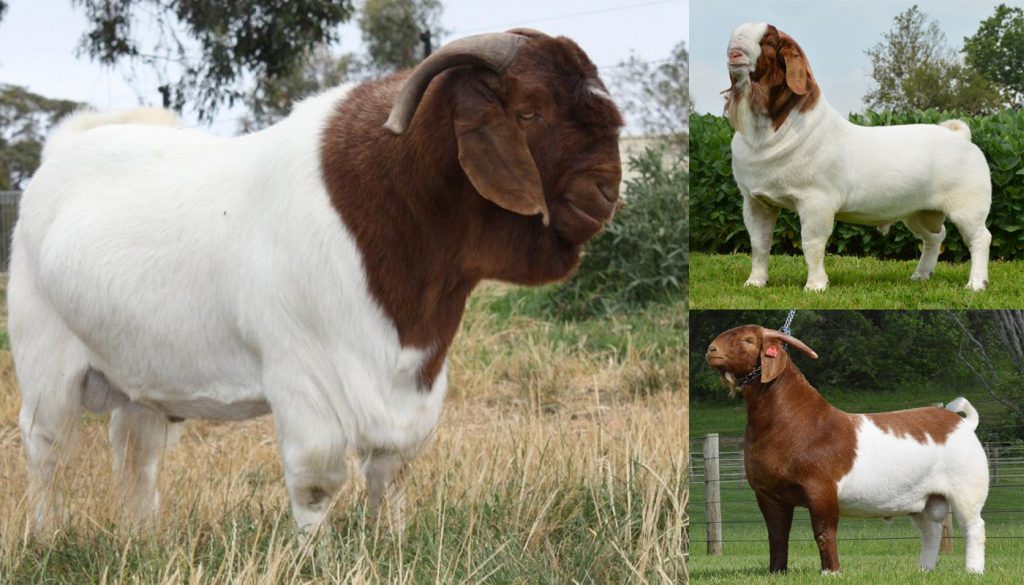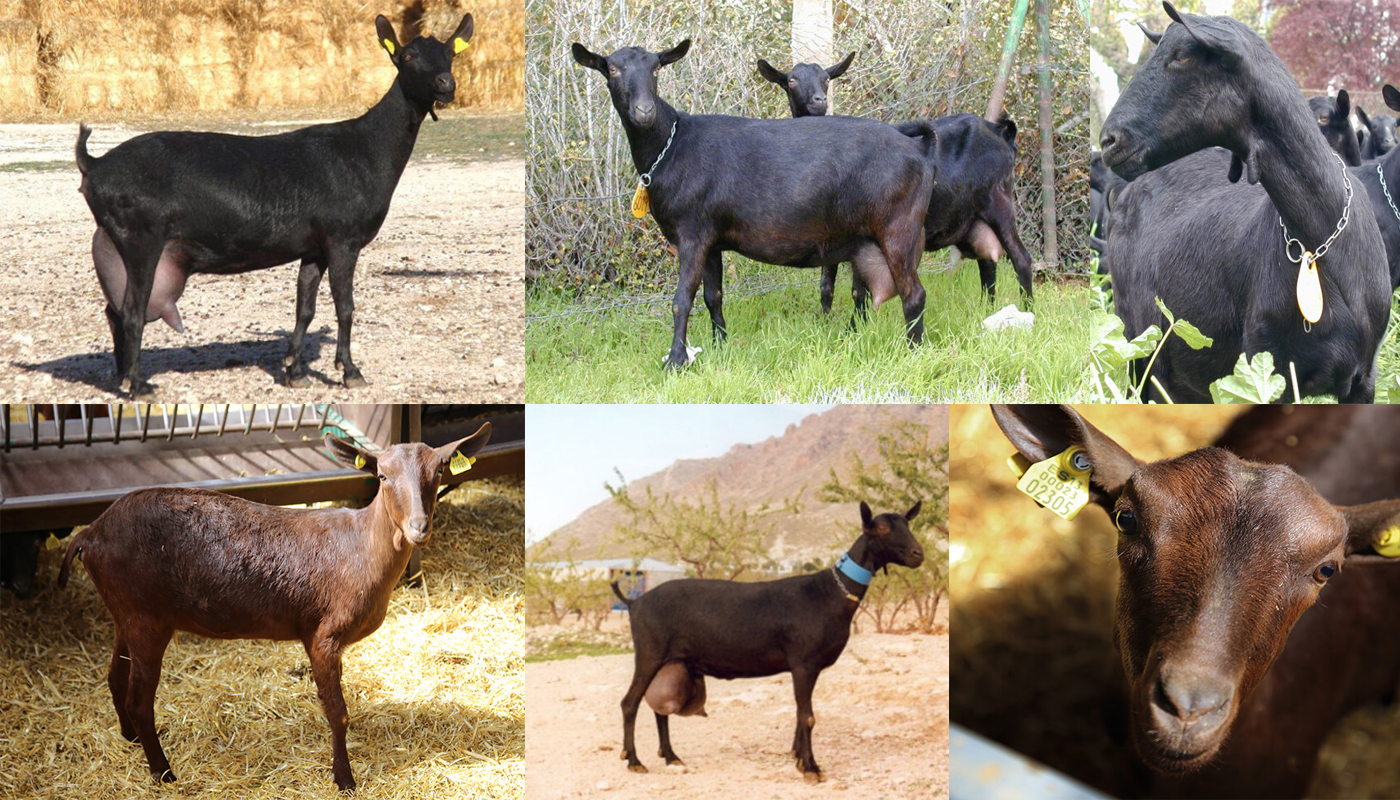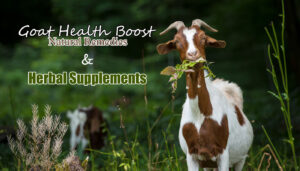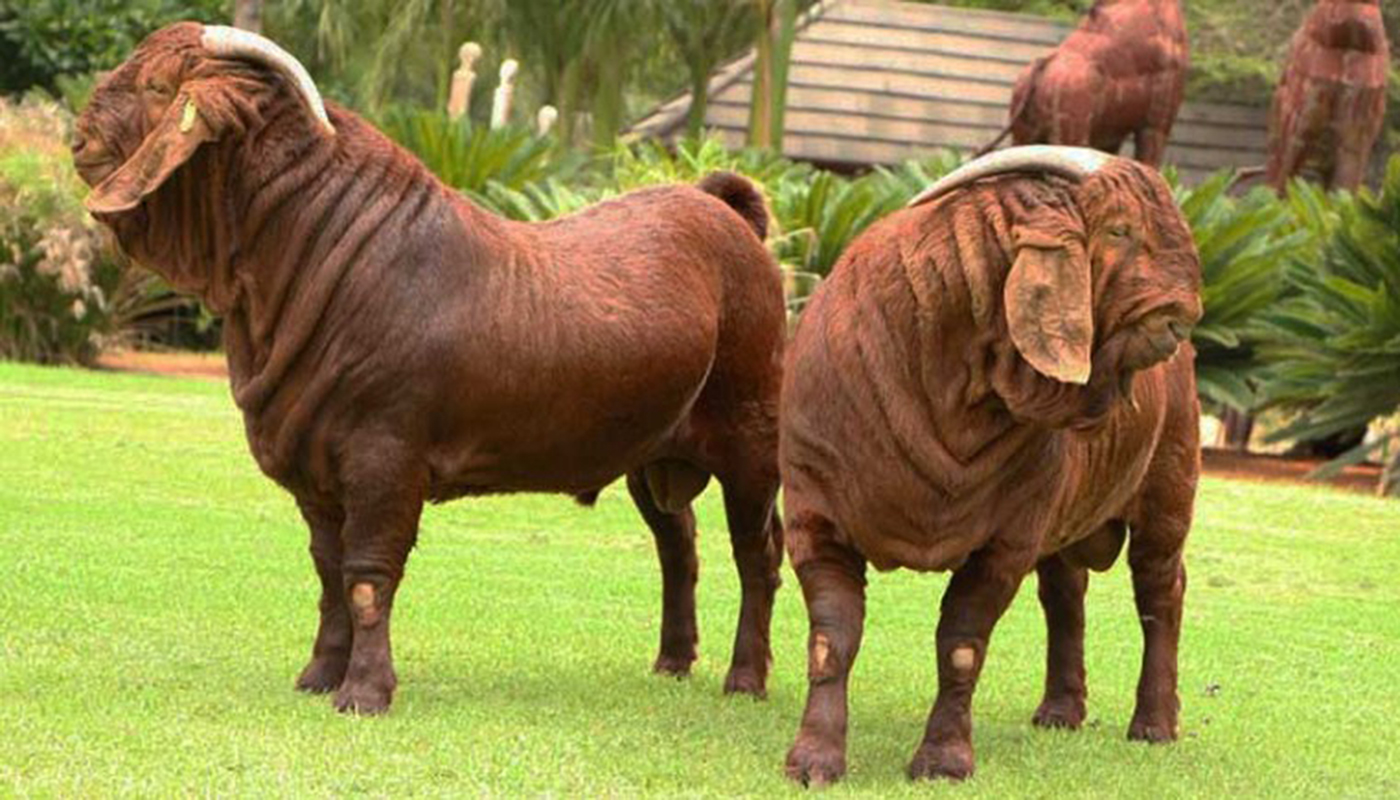
The Boer Goat is highly regarded for it’s meant and docile temperament. They are larger than most other breeds of goats and adapt to just about any climate.
If you are looking for a gentle goat that will give you milk, great for breeding and has an entire club just for showing them off. This is the goat!
Physical Characteristics
The Boer goat is a goat that usually stands out amongst other goat breeds as it has quite a few unique characteristics when compared to other goat breeds.
Some of these characteristics include:
- The Boer goat both male and female usually have either a brown or a red head.
- Some Boer goats’ entire bodies from head to legs may be completely brown or completely white.
- Those with either brown and red heads will have white bodies.
- Both the buck and doe have the same type of coloring.
- They usually have long ears that are flattened to the sides of their heads. Their ears are usually described as “long and pendulous”.
- They are usually notably larger than other goat breeds.
- They have a very even, docile and mostly calm nature.
- They are very fertile goats
- They grow very fast, maturing rapidly which is one of their prime qualities as a meat goat
- The Doe has been known to be excellent mothers more so than most other goat breeds
- The Boer goat easily adapts to most climates and landscapes with ease.
Buck
The buck has much the same color as the doe but is usually slightly bigger.
If their horns have not been disbudded when young or dehorned their horns are usually quite thick and curled to behind their ears.
The buck will reach puberty at around 7 to 10 months of age and can start breeding at around 5 months old.
These big boys are rather gentle and docile guys that will lazy graze the day away or go exploring.
Doe
Most Boer goats that are not exhibition goats but used for meat and breeding are not as large as exhibition does.
The Boer goat female is what they call “polyestrous” this means that they can be breed throughout the year and not just seasonally.
Some female Boer goats can almost reach the same size as that of the males. But their horns tend to be a bit slenderer and are grown backwards on their heads tending to stand up above their ears.
Their heads are also not as large as the male’s head is.
The doe reaches puberty at about 5 months old when she will become fertile. Some breeders will not breed her for her first year though.
Quick Overview
| Color(s): |
Head is red or brown and their bodies are either pure white or completely brown. There are some that’s entire body may be either completely brown or white from head to hoof. No difference in coat color between the male and the female Boer Goat breed |
|
| Goat⇒ | Doe | buck |
| Breed Weight: | 198 to 220 lbs. | 242 to 297 lbs. |
| Breed Height: | Ave. is 70 cm at withers | Ave. is 78 cm at withers |
| Hair: | Short glossy coats | Short and glossy coats. |
| Ears: | Long pendulous ears that are normally the same color as her head | Long pendulous ears that are normally the same color as her head |
| Horns: | Not as thick as the bucks. Her horns stand up over her ears pointing more backward from her head. | Thick horns that curl back around the ears |
| Matures at age: | 5 to 15 months | 3 to 15 months |
| Puberty Age: | 5 to 6 months | 4 to 9 months |
| Breeding Age: | 18 months | 1 year |
| Breeding Traits: | 1 Breeding cycle | Cover 20 to 30 does in 1 season |
Caring for the Boer Goat
The Boer Goat is no different to other goats in that it will eat almost anything. It is always best, however, to ensure that the goat is given good feed and supplements before being let out to graze for the day. This ensures that they stay healthy and if being used for meat production greatly helps with the taste and quality of the meat.
They are pretty climate adaptive and during the day will pretty much take care of themselves.
They will need to have weekly healthy checks to ensure that they are pest free and do not have any abrasions that could become troublesome or attract pests such as blowflies.
Known predators
Unless you live in an area that has large cats, coyotes or wolves, these goats are quite big so the normal predators such as fox, smaller cats and snakes do not go for them.
They will, however, go for the kids so it is best to keep kids in close proximity to the goat’s house for their safety until they are big enough.
Feeding the Boer Goat
Goats will pretty much eat anything they come across. This is why it is a good idea to always completely and safely dispose of waste products or make sure any waste is kept completely out of their reach.
Mostly Boer Goats love corn, green grass (they are excellent lawnmowers) and will try to get to the highest tree branches for the sweetest leaves. Some people do not realize that most goats are excellent climbers and trees are a breeze for them. Even the tallest of trees and can stand on branches that look too flimsy to take their weight.
If the leaves at the bottom of a tree are all but finished the Boer goat will attempt best they can to get to the higher branches as green leaves are their favorite grazing snack.
The normal Boer goat tends to be less heavy than the exhibition one, this is true of both the male and female.
Thus, it does not take as much feed as a show Boer goat and is really easy to maintain as they prefer to graze for the major portion of their daily diet.
You must ensure that they have sufficient troughs of clean fresh water on a daily basis. It must be located in their house and around the grounds where they graze. This will stop them from drinking water that could be contaminated with parasites and other toxins.
A few tips about the Boer Goat for exhibition
Even though the Boer Goat is a production goat that is prized for its meat. These goats are also prized as exhibition goats. Farmers/Boer goat owners take great pride in showing off their exhibition Boer Goat and raise them specifically for this purpose.
An exhibition Boer goat will weigh a lot more than the average production Boer goat. It is also specifically bred and then groomed to standards that are set out in the American Boer Goat Association.
The exhibition Boer goat takes a lot more special care, feeding and grooming than the normal Boer Goat does.
For comprehensive information on breeding exhibition Boer goats and the standards, it is best to go to the American Boer Goat Association. This site will outline the guidelines for this breed and what they look for in a competition or for purebred breeding stock.
There is various Boer Goat breeders club that is also usually listed on the American Boer Goat Association website (the link to this site can be found at the end of this article).
Milking the Boer Goat (if they can be milked)
Although they are not bred as milk goats they can still be milked. It is good to note though that the doe will only lactate for up to two months before drying out. They are bred to only lactate for only as long as their kid requires it. They will usually dry out in about three to five months.
Their teats are not as well placed as a breed bred for dairy production making them quite difficult to milk. This is not comfortable for the goat or those trying to milk them. They teats, however, are well placed for their kids so there are no issues with kid feeding.
Their milk does have a high-butterfat quality making it really nice for butter, cream and cheese. It has also been said that the Boer Goats milk and milk products have a very nice taste.
Boer Goat fiber production
There are a few types of Boer Goat hair types. You get the long haired and short haired. The Long-haired Boer Goat is the less desirable of the breeds. It has a heavier coat than the normal Boer goat and this makes the skin of the goat, less valuable.
The normal or improved Boer Goat is the general one used for production, breeding and exhibition.
For production purposes, the color conformation of the goat makes the skin and fiber more desirable as lighter or pure colors without patches or mottles are more desirable for fiber production.
Most production farmers will pick goats with fewer patches on their skin and more full colors if they are wanting to produce meat, fiber and leather. Being able to produce more from a goat allows for great profit from the animal.
Boer Goat leather production
The Boer goat has desirable leather as a full-grown Boer Goat has a larger carcass giving a greater leather yield. The quality of its leather is also quite good as the goat has a fine skin light color skin which makes it excellent for tanning and other leather processes.
Boer Goat and meat production
As they are bred specifically as a meat goat they tend to have a high-quality tasty meat with a very good yield due to the size of the goat.
Due to selective breeding processes, the Boer goat also grows and mature fast making it ready for slaughter at around ninety-days old. The average weight for slaughter is generally 49 lbs. to 79 lbs.
The Boer goat can be used for its meat up to a year old thereafter the meat may not be as tender, will be a lot darker and may have more sinew.
The Boer Goat as a pet and around children
The Boer Goat is one of the best breeds to have as a pet and it is really great around children. It has a gentle, laid back and easy-going nature. The does are actually quite nurturing and have been known to nurture smaller children or other animals such as puppies.
They have been labelled as “gentle giants” because of their laid-back easy-going nature. They are, however, just as inquisitive as other goats which can sometimes lead them into trouble. Especially if they are following a child in play.
More and more people are buying these friendly goats more for their personalities as a pet than anything else these days.
The Boer goat has no problem mingling and socializing with other animals or poultry.
They will adapt to most goat herds as well.
If you are breeding Boer goats it is best to keep them separated for other goat breeds if you are either showing, breeding them for meat production or to sell.
Good to know facts about the Boer Goat
For information as to where to buy a Boer goat, it is best to check with local goat farmers or the American Boer Goat Association who has a list of registered breeders from all over the country.
The Boer goat has an average lifespan of between 8 to 12 years old and can breed right up until about 10 years of age.
The Boer goat has excellent balance and that is what makes them able to skillfully climb trees and balance on very precarious edges. They can also jump very high some have known to jump over 3 to 5 feet.
The Boer goat’s eyes are not typically round they are squarer. They also have excellent night vision which enables them to get around at night just as well as they would during the day.
Where to buy them
For information as to where to buy a Boer goat, it is best to check with local goat farmers or the American Boer Goat Association who has a list of registered breeders from all over the country.
Peaceful Pastures, Able Acres Boer Goats and Boer Goats Ranch for goats or to find local Boer goat sellers near you.
HISTORY
The Boer goat was developed in South Africa in the 1900’s. It is believed to have been produced by the crossing of goat breed indigenous to South Africa. These breeds would have been breeds such as the Fooku, Namaqua San and some other breeds that came from various European countries as well as India.
They were bred by South African Dutch farmers who became known as the Boer with the word Boer meaning farmer.
The Boer goat was developed specifically as a meat goat. Developed to be hardy and withstand any climate, be able to produce a bit of milk but mostly have the meat of the highest quality and flavor. This was most definitely achieved as there are not many if any, breeds that can rival this breeds meat.
They are bigger in size and weight than most other breeds with an exceptionally calm and docile nature.
These goats were, through the years, selectively bred mainly for meat productions and as such the breed improved through time to the standard we have today.
This selective breeding of the goats to create a top-quality goat also led to the goat being a fast grower. They are also highly fertile and as such are very easily bred.
The Boer goats in America were first shipped in from New Zealand stock in 1993. 1993 was also the year that the American Boer Goat Association was formed. It was not until around 1996 that the Boer goat was directly imported from South Africa.
The American Boer Goat Association has set standards for these goats and the showing of them.
There is a very high demand for good quality lean and healthy red meat for which goats’ meat is among the top meats.
The USA estimates that the importation of goat meat into the country is over thirty-million-dollars a year.
Even though the Boer goat is native to South African the American Boer Goat Association can boast at being the biggest Boer Goat Association in the world. With over seven-thousand members registration annually and an estimated one-hundred-and-forty to four-hundred-million-dollars meat sales a year.
It is said that this breed of goat has had one of the greatest impacts on the American Goat meat industry!
VIDEO
USEFUL LINKS
- American Goat Society(AGS)
- American Goat Federation (AGF)
- American Dairy Goat Association (ADGA)
- American Cashmere Goat Association (ACGA)
- Canadian Meat Goat Association (CMGA)
- Canadian Goat Society (CGS)
- Animal Shelter (ASPCA)
- American Veterinary Medical Association
- American Poultry Association
- American Animal Welfare Society
- American Animal Control
- American Animal Husbandry Society
 Sable Saanen Goat Breed – Everything You Need to Know
Sable Saanen Goat Breed – Everything You Need to Know Dutch Landrace Goat Breed – Everything You Need to Know
Dutch Landrace Goat Breed – Everything You Need to Know Murcia Granada Goat Breed – Everything You Need to Know
Murcia Granada Goat Breed – Everything You Need to Know 10 Best Goat Breeds to Keep as Pet
10 Best Goat Breeds to Keep as Pet Managing Hoof Health in Goat Breeds: Tips for Preventing Lameness
Managing Hoof Health in Goat Breeds: Tips for Preventing Lameness Kiko Goat Breed – Everything You Need to Know
Kiko Goat Breed – Everything You Need to Know Goat Health Boost: Natural Remedies & Herbal Supplements
Goat Health Boost: Natural Remedies & Herbal Supplements Verata Goat Breed – Everything You Need to Know
Verata Goat Breed – Everything You Need to Know Russian White Goat Breed – Everything You Need to Know
Russian White Goat Breed – Everything You Need to Know 11 Smaller and Miniature Goat Breeds
11 Smaller and Miniature Goat Breeds Kalahari Goat Breed – Everything You Need to Know
Kalahari Goat Breed – Everything You Need to Know Appenzell Goat Breed – Everything You Need to Know
Appenzell Goat Breed – Everything You Need to Know